Gaming related personal diary with a focus on retro content.
Don't wanna be here? Send us removal request.
Text





Puyo Puyo
This is getting out of hand… why are these games so costly? All I wanted was to collect cartridges much like trading cards- wait no, bad example: those things are more akin to a guy's retirement funds now. Boy, the whole hobby industry is in shambles… Anyway, here's just one game I found under 20 euros recently and luckily it's a fun game too: I'm quite a fan of Puyo Puyo and never disdain a match!
This series shouldn't require introductions: originally developed by Compile in 1991, nowadays Puyo Puyo is mostly considered Sega's counterpart to Nintendo's puzzle titles (step away, Columns!) but up to 2001, it was pretty easy to find Puyo titles for quite a lot of consoles- afterall, its debut was on none other than the MSX! There are more than 30 chapters to this lenghty puzzle saga, the most recent of which published in 2024, so yes, it's an ongoing series! As for what it concerns the Game Boy, Puyo Puyo has a total of five titles, of which the one above is the very first. It is also a port of the original MSX game! Gameplay wise, this is just what you should expect from the most classic Puyo Puyo matches: action matching puzzle that can be played both against the computer or another player via Link Cable, make combos and think fast to deal more and more damage to the opponent's screen! I really like it (like most puzzle games to be honest!) but if I have to add a comment about it... I'd say this particular version isn't suitable for short-sighted players! The Puyo bubbles are very very tiny and despite the Game Boy doing its best making them clear and distinguishable it's not always easy to understand what combination is coming down at first glance. If you really want to play Puyo Puyo on the go on the little brick, maybe one of the later titles would be more suitable.
One last thing! Did you know the recurreing characters from Puyo Puyo actually come from Madou Monogatari?
1 note
·
View note
Text





Legend Of The River King GB
There's a whole lot of confusion regarding the Umi No Nushi Tsuri / Legend Of River King series, so much that I got gifted a random cartridge back in May convinced that it was a japanese exclusive but then I found out it recieved an international release... so I waited to add it to my collection until I could get my hands on a version I could actually read. You know my rules: I only get one version of the same game but I always strive to find the best one! In this case, the Legend Of The River King photographed above has been released originally in Japan as Umi No Nushi Tsuri 3, then got translated as a grey cartridge simply called Legend Of The River King, then re-released twice in a black cartridge enhanced of Game Boy Color as Legend Of The River King GB and Legend Of The River King GBC (this last one just for Australia).
Goes without saying that just like Link's Awakening DX, the Color compatible cartridge was the best version out of all these, so I went on a hunt for either the GB or the GBC labelled titles. While UNNT3 and LOTR in grey cartridge have somewhat affordable prices, the other two were much more expensive! GBC in particular was nowhere to be found with only one listing of a boxed version going for almost a thousand... I settled for a GB listing that went for under 40 euros and was thankfully legit, so everything concluded for the better in the end.
About the game itself, this is another long-running Natsume developed RPG which shares the heavy nature theming with another one of their series, Harvest Moon. The premise is as simple as it gets- with the protagonist leaving his home to find the Guardian Fish, a legentady creature and the only cure for his sister's illness; however, the graphics are immersive and impressive with lush river shores and green forests of rural (implied) Japan, even more beautiful with the coloured palette given by the Game Boy Color. If it's so expensive there must be a reason: LOTR was heavily ignored during its time but it's a real gem in the rough and a story that deserves to be played. If you want a precious addition to your collection and you have some extra earnings to spare, I'd say go for this one!
0 notes
Text





Daikaijyuu Monogatari: The Miracle Of The Zone
Aaah, the cozy feeling of having a complete series in your collection. :3 This here is the first chapter of Miracle Of The Zone, a Birthday/Hudson developed trading card game based on a previous series of RPGs published on the NES. I had already acquired the sequel last May so I wanted to get the missing chapter as soon as possible.
Being this a game that came from Hudson Soft, it's not surprising to find it using the GB Kiss technology, of which I've talked about in a previous Link post detailing sections of a site that gathered a lot of information about this special infrared mechanic; however, it strikes me as odd that only the first chapter of the series has the GB Kiss option while it seems to be non existant in the second. Apart from that, just like said for Zone II, this game is incredibly similar to Pokèmon TCG so if you like that game and if you're familiar enough with the japanese language, this series might be up your alley!
I've also discovered that Daikajuu Monogatari was also an actual card game, while I initially thought that its TCG popularity in Japan and Asia was exclusively in virtual form. That explains why BoardGameGeek has a dedicated page with some photos (but no real rulebook, dang!).
0 notes
Text





Shaman King Chou Senjiryakketsu: Meramera Version
You know how much I hate leaving series incomplete in my collection! Here's the brother cartridge of previously acquired Shaman King Funbari, one of the games I randomly got at the latest Novegro Comics Festival.
I'm still a bit confused by the double version nature of this trading card slash turn strategy game, as frankly it appears that the two cartriges won't communicate with each other- neither via Game Link Cable nor with the infrared port (at least, no one on the net seem to mention anything of the sort- and the box/label graphics don't have the classic "linking" Game Boy icon, so yeah). So what was the point? Was it all to copy what monster collecting games were doing at that point in time and potentially cash double the buck?
As you can expect, Meramera and Funbari present the exact same game but with a few differences. For example, Meramera lets players impersonate characters Tsuyoshi, Kevin and Kana. Once again I don't have much to say, the genre isn't up my alley... but I'm still amazed by the graphical quality of the cutscenes and character portraits: it's like watching an episode on TV!
2 notes
·
View notes
Text





Daikaijyuu Monogatari: The Miracle Of The Zone II
Lastly, we have yet another game heavily linked to another cartridge that I'll have to look out for in the immediate future so I can claim its series complete in my collection! I even got the sequel first; what's wrong with me >.>
The Miracle Of The Zone for Game Boy is actually a spinoff series of an RPG saga for the SNES called Daikajuu Monogatari, developed by the company Birthday starting from 1994. The original games see the protagonist face against several natural disasters sent on Earth by the main villian Fattobajah and features up to ten playable characters, along with being known to be rather unforgivable and laced with many, many random encounters and unforgivable dungeons. On the Game Boy, Daikajuu Monogatari became instead a trading card game much like Pokèmon Trading Card Game, in which the players battles NPCs, wins more cards and advances to the next battle; in Japan, Miracle Of The Zone's mechanics became so interesting and loved that the spinoff surclassed its main series by a long shot, gaining a full reboot on GBA completely stripped of the original Daikajuu Monogratari theming and rebranding itself as Miracle V Master.
Much like Card GB2, Miracle Of The Zone II mainly adds more cards to the previous game but keeps its core gameplay the same. There's also a bunch of aesthetic improvements (obvious since we're talking about a black cartridge) and the choice of boy or girl protagonist, again just like in Card GB2!
Without a rulebook and a good knowledge of the japanese language this game would unfortunately be unplayable, but a very recent complete guide has surfaced on the web, detailing every single aspect needed to play Miracle Of The Zone. So now you have no more excuses! xD
0 notes
Text





Sylvanian Families: Otogi No Kuni No Pendant
The second game I got at the May edition of Novegro Comics Festival was one from the Sylvanian Families series, which is one of those I've been looking to start for a long while since I absolutely adore the cute aesthetic of these toys!
Sylvanian Families is a line of collectible toys (dolls, figurines?) created by the japanese company Epoch in the 1980s, whose figures have the main peculiarity of depicting anthropomoprhic animals in a very fairy-tale style and being completely covered in a short fuzz that makes them soft at touch. The figurines come with an incredible variety of clothing, accessories and playing sets so players can create any kind of story with them. In Italy they're considered a cross between "Lego for girls" and "Barbies for plushie lovers", also often confused for the toy versions of cartoons Palm Town and Maple Town, which of course had a huge popularity boom in the country when they first got broadcasted.
The Game Boy line has a long history with Sylvanian Families adventures as seven games got published for the systems, four of which on the Color. Otogi No Kuni No Pendant (which can be translated as "Pendant of Fairytales") is actually the first ever title of the collection, published directly by Epoch in 1999. Don't be fooled by the "girly" premise, this one is a mix between role-play game and visual novel with minigames sprinkled in between and packaged with such beautiful and colorful artwork that just makes me curious to see how the later chapters could ever improve on this!
The story follows Aster Dandelion, a young rabbit that recieves a magic pendant as a gift from an injuried fairy that Aster helps healing. Each day at six o'clock, the pendant mixes dreams and reality creating many fantastic yet chaotic situations; Aster decides to return the pendant to Fairyland while she tries to carry on with her daily life. Being this a text-heavy game, it'd be recommended to know the language before playing... or you could check out the translation patch done by the CDRomance team!
0 notes
Text


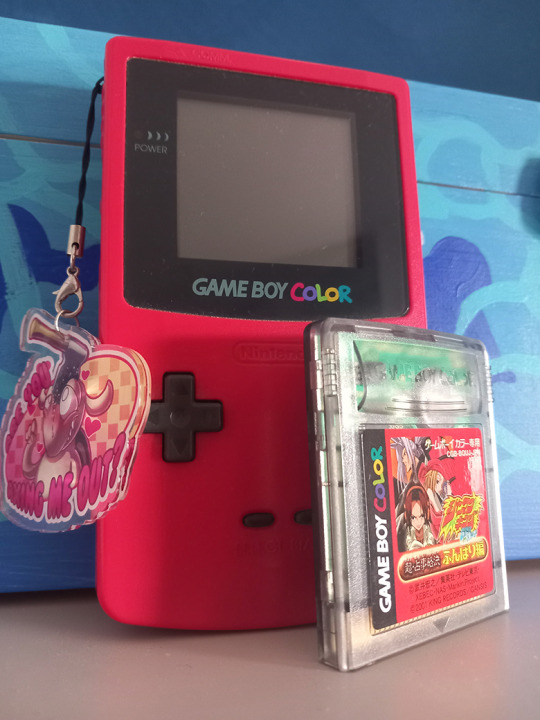


Shaman King Chou Senjiryakketsu: Funbari Version
I'm back from the Novegro Comics Festival, May edition! It's the first time we work at that location in spring and it was kinda odd to see it all sunny and warm instead of the usual foggy cold we get in winter. Anyway, I also scored a bunch of games and chitchatted with the fellow booth owners to the point that now I'm known by one of the retrogame sellers as "that Game Boy girl". Nothing to say here, best con ever whooooo <3
Today's game is based on Shaman King, a late 90s manga by Hiroyuki Takei that later got adapted in anime form and arrived on italian TVs as well, in 2005. By that time I was completely out of the loop for what it concerns animation and instead focused on other interests, so I can't say I know the series; however, I do remember the bit of hype it had while the episodes lasted, with merchandise going strong as always; also, as always, all this merchandise was cheap and easy to produce, so as you can imagine we never got around to experience the games dedicated to the series. Yay, it's yet another japanese exclusive of a videogame whose subject matter would have been enough to justify successfull production in Italy. But nope!
The story revolves around Yoh Asakura, a young descendant of a family of spirit tamers measuring himself against other shamans in a tournament that sees the winner getting invested with the title of Shaman King. It gets complicated, of course, but for the most part it's what you'd expect from a fighting shonen.
The Game Boy Color has the honour of hosting the first gaming chapters of the series: Chou Senjiryakketsu, getting published by King Records in 2001 in two versions, Funbari shown above and Meramera, which of course now I'll have to get as soon as possible since I like to complete series. Yes, apparently Shaman King wanted to pull off a Pokèmon Red and Blue move! Unfortunately I'm not a fan of the gameplay which turned out to be a card-based turn strategy, but oh the graphics are spectacular! Character dialogues and cutscenes are shown with so much impressive detail that they might have been directly lifted from either the original manga or the anime studies. Even the colour palette are impressive, and we're still talking about an 8-bit console!
Funbari and Meramera have very little differences between them, but the most striking change is the playable characters, with Funbari version allowing the players to take control of Kaita, Mitsuru and Maria. Wait, where's Yoh?
0 notes
Text





Street Fighter II
I came back from Lucca Collezionando! It was an odd convention, focused on vintage comics and toys so fanarts of 80s and 90s anime sold very well at our booth. Happy to have made some extra, I took a look at the retro toy area to see if there was something worth snagging! I came back with just one game but hey, what a game. (I also came back with a 90s Pokemon toy of which I'll take pics very soon, I just need to find its batteries first.)
Street Fighter II was sold to me at a bargain, so much so that I feared it was a bootleg repro board! Luckily that's not the case and the boy here is totally original. We all know fighter genres are not the Game Boy's strongest suit, but along with King Of Fighters, Street Fighter ends up among the best. It's certainly better looking than any Game Boy Mortal Kombat: just by choosing cartoony sprites over pre-rendered ones the characters become recognizable instead of being a mess of pixels. Now if only they went for a slightly chibi style like KOF they would have been even better suited for the small screen, but we take what we have.
The soundtrack is certainly where this game shines the most. It's long, elaborate and has many great tunes! All songs together add up to one hour of music! SF for GB lets you play with nine characters total on eight different stages, has both Classic and Arcade mode along with a Versus one playable via Cable Link, and fighters can finally display all their moves. Once again, better than poor Mortal Kombat that had to take away its fatalities! It's even pretty responsive with controls (has to be, otherwise it wouldn't be called one of the best fighters for Game Boy) but the big downside is that it renders everything like molasses so matches feel like slow and strategic instead of quick and full of action.
In truth, I've seen far worse: the Game Boy version is nothing compared to the many ports Commodores and Amstrads suffered during those years; unfortunately, I've also seen better: considering once again that the Game Boy shines best with way different gaming genres, one would be ovbiously better off playing Street Fighter on SNES and arcade, where it was originally intended to run.
0 notes
Text





SD Sengokuden: Kunitori Monogatari
Lastly, have a Gundam game! Well, actually it's an SD Gundam game. The "Super Deformed" series of Gundam parodies have an interesting origin story: it all started with a fanart made by a simple student, Koji Yokoi, sent to Bandai's magazine Model News which depicted a mecha with classic chibi proportions (big head, simplified lines, cute aesthetics). The drawing caught the attention of then president of Model News, who contacted Yokoi for a job offer of several comedic strips featuring Gundams in such style.
The style and parodistic approach to the mecha genre made it extremely popular among kids and the SD Gundams became a staple toy shape for Gachapon machines, whose Gundam brands started appearing in 1985; SD also worked well with alternative settings, so Bandai produced several manga and anime featuring the chibi Gundams in fantasy worlds, or sent back to feudal Japan, or even in a simple contemporary urban setting, just to name a few. In short, SD Gundam became a media franchise as big as the original Gundam itself. So yeah kids, remember to send in fanarts to your favourite magazine of choice! You never know how much staff will appreciate it.
Of course many Game Boy games were produced (often by Bandai itself) featuring Gundams, be them Super Deformed or not. This is one of them, published in 1990, taking back the small mechas in the Sengoku period, as title implies. I'll be honest, the origin story is the most interesting part of this thing for me, because most Gundam games are real-time strategies and I never clicked well with that genre. I suppose the handheld console works well with these kind of games, with the screen having to display simple recognizable graphics in order to have the map as a glance; but the sheer amount of info you have to know and manage in order to actually play these is nowhere to be found if I don't know where to look among game menus- no surprise there, there's a huge language barrier with this game being Japan only.
So yeah, I enjoy the item for what it is: the proof of a franchise who started with a cute fanart which caught the heart of original makers.
I'll be at Bologna Nerd Show in a few weekends and I hope to get some more goodies for my collection. Until next time!
1 note
·
View note
Text





Heracles No Eikou: Ugokidashita Kamigami
Have another game from the Novegro batch: this is Ugokidashita Kamigami, the only Game Boy chapter of the series Glory Of Heracles. The franchise, first developed by Data East, debuted in 1987 for Famicom and mostly thrived on the console and its Super sequel; the subject of this post is not only the sole GB title but also the only spinoff, and after a good hiatus the series ended with a DS entry in 2008, the only one to get ported in the west (North America specifically) as Glory Of Heracles.
As you can imagine its plot mainly feature greek legends and mythological characters; despite its name only two games of the series actually feature Hercules as the player character- luckily, one of these two is exactly the Game Boy title! In a classic RPG gameplay fashion, the player is tasked with preventing the invasion of evil forces by Zeus and therefore is sent to a top-down map to destroy everything in sight. Glory Of Heracles' major feature is the pantheon of Gods that assist Heracles and can be called into battle like fighter games tagteam charas- or Jojo-like Stands. They can be called only one at a time, but as the protagonist levels up their character choice expands for more power variety.
Even if just on the Game Boy, the story is rather long and features a good deal of dungeons; however, levelling up towards endgame reveals to be a tedious and slow task due to none of the enemies giving enough experience points on higher levels, a flaw that costed Glory Of Heracles many lukewarm reviews. At least it has a damn cool label!
0 notes
Text
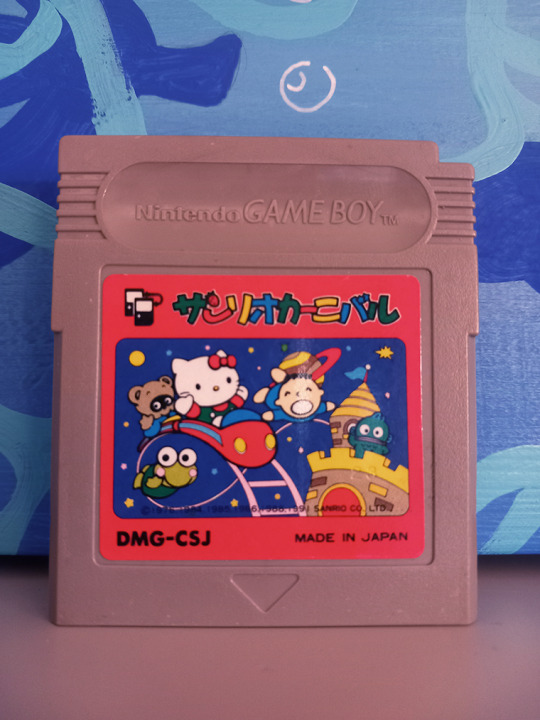
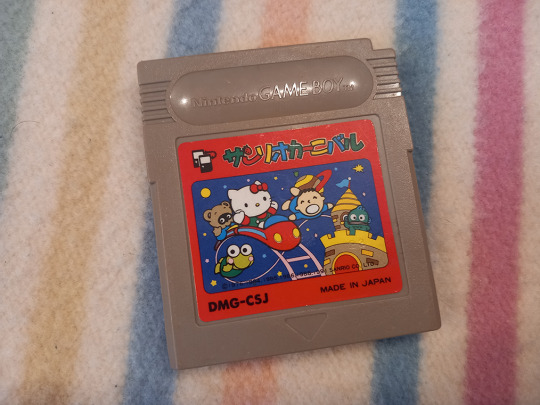


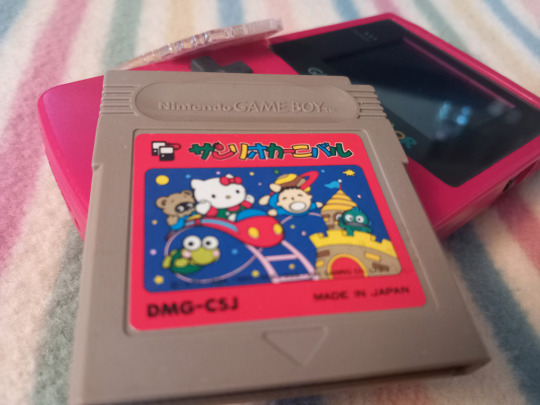
Sanrio Carnival
Second game I got from Novegro is a freaking Hello Kitty title. Never in my life I would have expected to come back home with Hello Kitty among my convention loot, but it was there for cheap and I figured it was better collecting these kind of games this way instead of also suffering shipping costs for them.
The minimal-styled white cat needs no introduction: designed by Yuko Shimizu for the Sanrio corporation in 1974, Hello Kitty has been an icon for worldwide kawaii culture since then and a fan favourite among children and adults alike, becoming a fixed appeareance in pop culture. Her most remarkable feature is getting her face plastered on anything mankind has ever produced; if an item exists, there's an Hello Kitty branded version of it. No need for me to delve further into the topic, since there's also a plethora of Hello Kitty Game Boy games and eventually, as I collect more titles, I'll come back talking about her sometime in the future. In reality, I hold no grudge against Sanrio characters in general. Really, they're adorable and I am known for liking cute stuff: Badtz-Maru is definitely my favourite in the bunch and I owned- correction, I still own Ahiru No Pekkle branded stationery (which, by the way, has major kidcore vibes. It's amazing). The big flaw here is that I think all minor, secondary or supporting characters Sanrio creates for the Hello Kitty brand look far more interesting than the protagonist who needs to be bland and empty to fullfill the role of "pop culture icon". While others have distinct personalities and attitudes, Kitty needs to be just a face, a signature, a stamp to be placed on items, nothing more. I know there's several anime series trying to give her a family or a story and a setting, but at that point it's just uncanny. It's sorta like watching a cartoon of the Dolce&Gabbana logo coming to life.
Setting my rant aside, the subject of this post is Sanrio Carnival, a classic GB game distribuited by Character Soft in 1991. It appears to be, along with its NES counterpart of 1990, the first title featuring the kitten at least on Nintendo consoles. Unfortunately, searching up info about older Sanrio games is a confusing task as most dedicated sites do not even bother to list them prior to the DS and GameCube era. The game itself, however, is not confusing at all: right after the title screen from where we can choose to play single or multiplayer via Link Cable we're sent to an option screen and then to the actual game- which is a Puyo Puyo clone. Nothing more, nothing less. Icons depicting Sanrio charas fall from the top of the screen in couples and the player can rotate and move them with controls; once three of the same are paired, they disappear.
While it's hard to write anything more about the game itself, I can say that ironically this is the best I got from the Novegro batch o.o I randomly picked all four titles only assuring myself I was getting actual japanese exclusives with no western distribution; I ended up with a text-heavy RPG and two RTS, while Sanrio Carnival is just a simple puzzle game. Granted, it has nothing on Dr.Mario or Tetris, but it's immediate to pick up and it fills the purpose of killing your time if you're a kid in a road trip or waiting in some office. It does its job. Sanrio Carnival is just a simple puzzler, yet it's everything you'd expect about an early title featuring fashion icons.
3 notes
·
View notes
Text
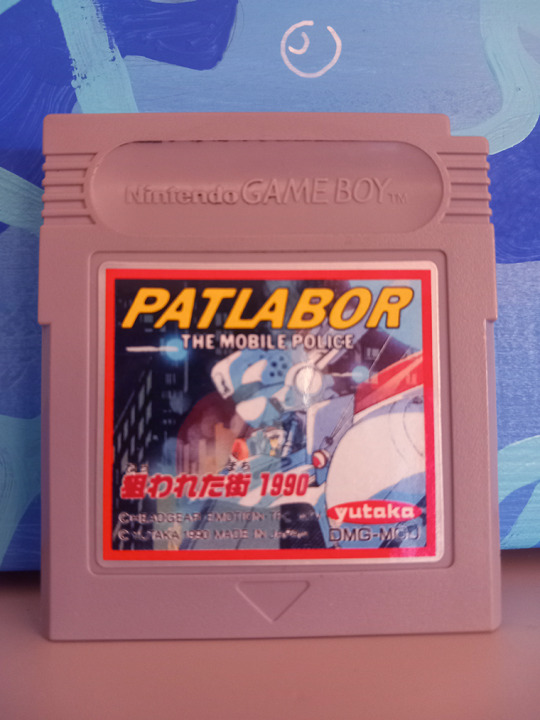

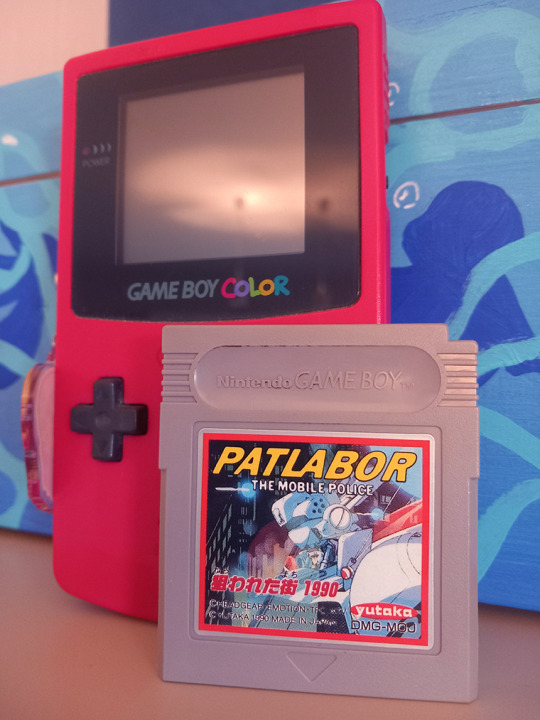
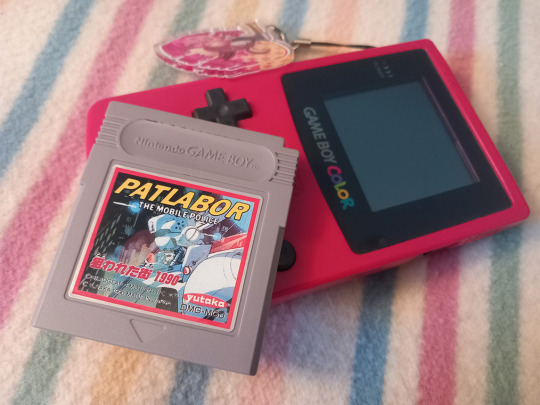

Patlabor: The Mobile Police
I got back from Novegro Comics Festival with the best revenue I made at a convention so far- and a couple of Game Boy imports for good measure. XD I stayed there at the retrogaming booth before the con would open to the public checking each and every cartridge while chitchatting with the seller. I love when cons have that "calm before the storm" where booth owners can actually talk with eachother and share passions!
Anyway, here's one of the new additions to my collection: I managed to get another anime tie-in, though Patlabor is known to be so much more. Created by the mangaka collective Headgear, Patlabor was a prominent media empire of the late 80s/early 90s spanning from a classic manga and anime to several OVAs, games and toys. It's a cyberpunk mecha saga, different from its contemporary counterpars Mazinger and Daitarn as it focused much more on the daily lives of human protagonists and the world around them, the Labor mechas only costituting a series of machines of in-universe contemporary technology and therefore not as special. So yeah it had a slow plot… but the visuals were something else! Italy loves giant mecha anime (we even have our own term for it) and couldn't pass up on the occasion to bring Patlabor to our screens. Both the OAV and the anime got translated in their entirety, although while the OAV quickly got a broadcast in 1994 on local channels, we had to wait until 2012 for the anime, which got distributed in DVD.
Videogames are another story, we didn't get a single one of them for the usual reason that translating a cartridge game in italian, no matter how popular, would always result in a loss due to extra manifacture expenses. Geeze, the more I look for new games, the more I realize it was a miracle we at least had Pokèmon translated! The Game Boy chapter, subtitled "The Targeted Street", was the second game dedicated to the series and got published in 1990 directly by Headgear. Being this an early title of the series and also an early release on the handheld console, I can maybe excuse its overall simplicity; however, it is also true that Patlabor looks so barebones in its gameplay to become rather boring and apparently, reviews of the time also weren't really pleased by it. The game lets the player move their mecha in some sort of top-down view board with the objective of defeating every other enemy Labor robots. Once in combat, the view switches to the side and the player selects a series of attacks which will be executed in turn with the adversary… and that's it, rinse and repeat. There's some minor RPG elements in the form of new skills and more resources for the player's mech, but that's really all there is. Which is sad because considering how refined the world of Patlabor is, you'd at least expect some more depth to its interactive adventures.
0 notes
Text





Pokèmon Picross
Here's a very special cartridge! At this point in time the story of lost and found prototype Pokèmon Picross needs no introductions, but to make it short: it was a Jupiter Corp GBC/GB compatible title announced way back in 1999 on japanese magazines and basically ready for distribuition, yet somehow axed by Nintendo because... I dunno, maybe they were getting tired of Picross after the Mario titles and the ones distribuited through Nintendo Power? Anyway, the game sat in obscurity labeled as lost media by worldwide fans until the megaleak of 2020 discovered this build so complete that it only missed a board and a cart. As someone who has always been happy to own all Pokèmon games for Game Boy, I've been looking for a repro of this since ever! I was lucky enough to find a dedicated listing on Ebay, but the seller had its copy in a grey cartridge (technically incorrect considering official colour coding) and I wasn't a fan of the game titlescreen getting used as the label. When the parcel got delivered, I moved the board into a spare original black cart I had lying around and designed my own label, using both official assets from the 1999 magazine previews and from the Mario Picross titles, as we most assume they would be used for this game as well. Really satisfied of the final result, also because I can't stand the poor quality of reproduction carts x.x they just can't compare to the originals! Also the box is nice, but there was no manual within (so no unboxing post :c ) and I doubt I'll be keeping it. So, how's the game? I've been playing for almost a week straight and each time I'm more and more shocked and sad this never got an official distribuition. It's a packed full game of puzzles with beautiful graphics (especially when enhanced on the GBC!) and even cutscenes during credits. There's a Pokèdex-album section where the player can see all discovered picrosses and print them out (I've tested it myself- the printer works!) . Really, the only aspect where I'm not completely sold on is the music which feels a little repetitive, but for a fan of the genre this would have been an amazing addition to their collection... and I know it is for me!
0 notes
Text





Tamagotchi II
See? Told you I'd be back! I got contacted for a cool art project that involved taking pics of my collection and had virtual pet games as main theme; since I was still missing Tamagotchi's second Game Boy chapter in order to complete the series, I went ahead and got it -luckily on the cheap side- on good ol' EBay. I wasn't expecting it to get delievered today, but hey, here it is! Just as I got back from vacations.
As far as the game goes, this Bandai title from late 1997 is exactly what you'd expect from a Tamagotchi game; the petcare side is the same as its previous chapter and as the egg-shaped toys that got released during that period; however, it changes its creature roster slightly as Tamagotchi II allows players to raise forest and ocean dwelling Tamas, all of which will be later featured in two toy series released in 1998. There's also a side mode in which the player takes control of Mikachu, walking around a small village to look for items and visit other houses, but most importantly find eggs hidden in bushes, trees and rivers to gain more Tamas to take care of. There's also Mikachu's own house from where the actual Tama game can be accessed, as it features a bug tank and fish tank (where Mori and Umi eggs are stored). This allows players to raise two creatures at once, doubling the play factor.
The cutest thing about this cartridge itself is that the original owner (presumambly a japanese kid) has scribbled their name on its back. Details like these on the cart's back are always my favourite! They don't ruin the cart's aesthetic quality and instead add a flavour of backstory and emotional value to each title. Kinda reminds me of the time I found a cart with a Pokèmon sticker on the back!
1 note
·
View note
Text
Posting A Few More W's
Oh hey folks! The site's not dead at all, don't worry. It's just that I have accumulated so many GB cartridges now that my current decorated storage boxes are full- and I'm still in the process of painting a new one to start hoarding more. Mine's an organized collection, mind you U_U
Nevertheless I've been playing a lot elsewhere, mainly on the Switch because I realized I have one at home I mean, its library of graphic adventures has plenty of interesting titles, but also on several other consoles as me and my brother currently have a knack for platforming adventures. We're especially looking at some 3d explore-and-collect titles released during the early 2000s on consoles we never had the occasion to try at the time: GameCube, PS2, the original Xbox. I feel like this was a generation I completely missed, as when Nintendo's cube came out I could only read about it on magazines while I played my GBA (still very loved of course!) and its Sony and Microsoft rivals were pretty much unreachable for me (I doubt I was even aware of the Xbox's existence at the time, incredibly).
Anyway, wanna know what's the best thing about these 3D platformers? They all have a screen displaying your progress and all available collectibles, something that pushes players to go for a 100% complete run (which is one of the things I love the most about games- pretty sure the Pokèdex started this obsession of mine) and that's very easy to take a snapshot of, in order to show off the completed mission. So here's a gallery of our completed games! This is a spiritual sequel to my post about personal gaming achievements, as I feel seeing these screens is an achievement of its own.
Vexx
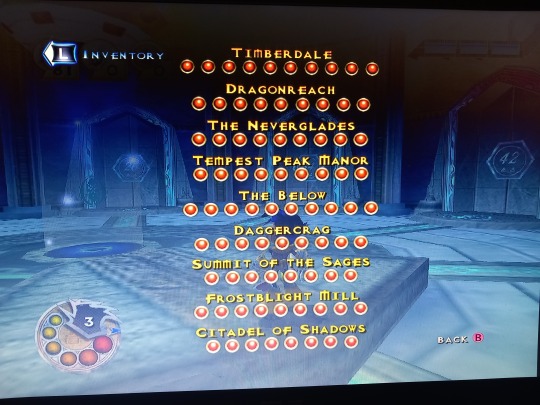
Vexx is a game with a very odd charm to it. My brother hates it and I partly agree with his distaste: it's flawed, oftentimes buggy, most of the difficulty is due to its unpolished controls. However I feel it also oozes with style, tries to paint a bigger picture than what's shown ingame and it's clear there was a special passion put into it, the developer team wanted to impress. I like the edgy protagonist and his design; I remember looking at a few dedicated advertisements and being very curious about it. Nevertheless, I admit taking this game to full completion was quite a pain! I'm proud of this screencap.
Super Mario Sunshine
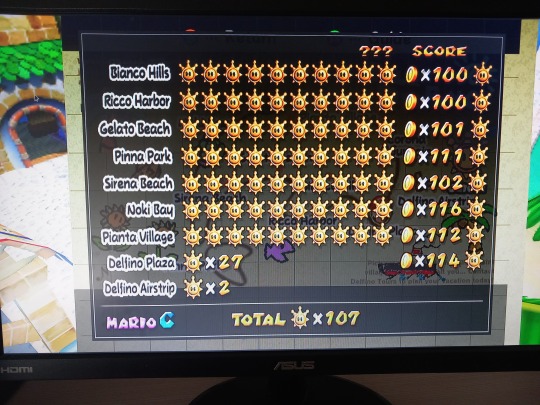
This title is a white whale for many players, since like half of the planet forgot the GameCube existed and now it racks up thousands on the secondhand market. I've always wanted to play Sunshine, it's the only 3D Mario chapter I was still missing and the reason why I was so very tempted to get 3D All Stars, yet I knew the Switch's emulation of the Cube was subpar. So we emulated it elsewhere. :V This game is so short! Everyone treats it like a gem and the general hype and mystique surrounding it might have elevated my expectations too much. Nevertheless we had fun, but less than what reviews promised us and if we have to choose, we'd still go for Galaxy over this.
The Incredible Machine
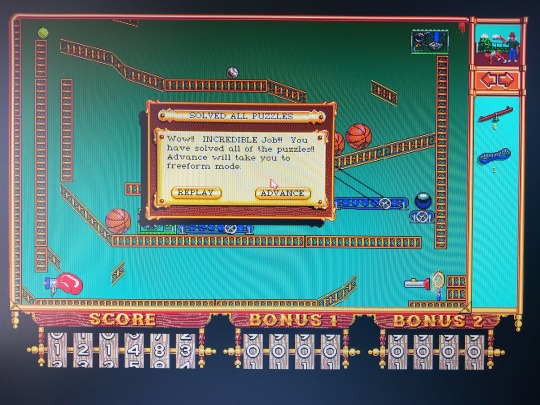
Oops, here's the odd one out of the list. :P Me and TIM go way back, I already talked about this game in one of my earliest story posts and it still bears an important heritage in my childhood; however, I could never finish it back in the day! The later puzzles were too complex for kid me and my english was still extremely unripe to understand what I had to do in the stages. Seeing this screen would make younger me very proud!
Ty The Tasmanian Tiger
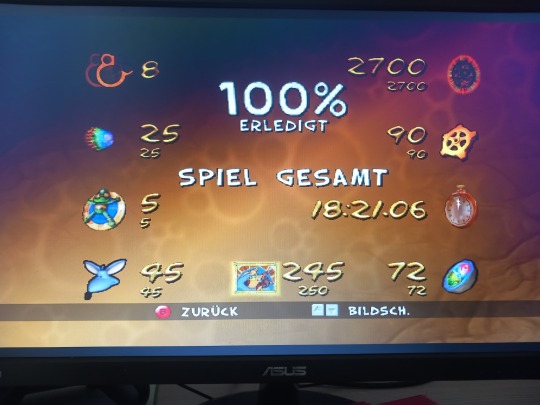
If there was a class for mid 2000s abrasive platform mascots, Ty would have graduated with pomp and circumstance. This game follows every aspect of that trope to a… Ty. Antropomorphism, unusual species, comparative and aggressive advertising, catchphrases, characters trying to crack jokes every single time, an evil clone, the bad guy using robotics for end level bosses, big levels with lots of secret areas and tons of collectibles. Granted, not everything listed here is a bad thing: I appreciated the representation of australian fauna and enviroinments, also big levels and many collectibles were exactly what we were looking for when me and my brother started scouting for games to play. But there's also a huge level of unpolishness to it, like we played a beta of the game: it got too easy too fast with one of the boomerang powerups being an infinite machine gun and the other a literal nuke who automatically eliminated enemies (not that they were a threat before- we never got a game over); other boomerangs were barely employed in puzzles and game mechanics; transitions were nonexistent making cutscenes and level warps end abruptly; the sound design was especially lacking; the fire particles were absurd and we couldn't understand where it began and where it ended; similarly, the lacking shading on many platforms made jumps difficult. We got into a disagreement because I feel like this game should rank worse than Vexx while my brother swears it's Vexx still being inferior to this. We can't come to a conclusion on that. Anyway, this is as far as we can manage to go with Ty; the game is 100% complete with all collectibles except, sigh, five concept art collectibles out of 250. We literally combed all levels three times for them and like Dark Helmet's subordinates we ain't found shit. Also 250 concept art pieces? It really shows the game didn't fill up even a quarter of the disk (we were impressed on how short it was). If you're wondering why the screen's in german, my brother got quickly tired of the australian voice accent and wanted to hear all the other dubs. XD Are we gonna play the sequels? Fuck no!
I may get back to this post for the rest of the summer if we manage to take a picture of another completed collectathon! Otherwise, I'll make another in the future!
0 notes
Photo





Medarot V Susutake Mura No Tenkousei: Kuwagata
As a kid, Medarot's cartoon never striked me as something I'd watch with actual interest. Without anything interactive to back it up for us in Italy, there was no doubt that the franchise was doomed from the start; even nowadays I wouldn't be able to watch any episode, the plot feels way too childish and character behaviour feels clichè at best, abrasive at worst. But it's in its graphics that the world of bots really stands out. Growing up and approaching my drawing career with more seriousness, I happened to study different mecha designs overtime and went once again back to Medarot as they were a good example of toony, organic and simplified robot styles; Horuma Rin gave these metal characters the same squishiness of flesh, giving them expressions, personality and life: his human style ain't nothing special, but then again they're not under the spotlight in this case.
Graphics are the exact reason why I find Medarot games much more endearing than its anime: it's their perfect emulation of Pokèmon-syled RPG proportion and assets that washes me with a strange sense of nostalgia in every single screen. Despite never having played these games before, they still all feel so familiar. This gaming saga has evolved alongside Pokèmon and many of their subsequent choices, from the card-game spinoff to how the GBC sequels look, seem to have been influenced by Pikachu and friends. I haven't taken a look at the most recent chapters, but I'm willing to bet Medarot also has recently stopped using a grid-based navigation in favour of 3D free roaming on the map. :P I'll be definitely taking advantage of the translation patch to play its "first gen" in its entirety.
11 notes
·
View notes
Photo





Medarot V Susutake Mura No Tenkousei: Kabuto
Ouff, that was quite some wall text of research! I wouldn't have been able to fill up almost fourteen posts concerning the same damn argument (did you actually read all that? Seriously?) if it wasn't for the many useful links I've found all around the net. Credits are overdue!
First off, if you're interested in more info about the games but mostly you're curious about the robots' sprite or official art, check out Medapedia which has a nice collection of illustrations! If you know japanese, the official site of the franchise is a must to check which also links to the official flan club. However, there's also something for english-speaking fans with the Project Rising Beetle fansite, providing a good deal of news related to the anime, games and overall franchise status. In particular, the site has been a key part in the effort of translating Medarot 1 and still provides a translation patch for everyone that wants to get into the series even without japanese knowledge.
2 notes
·
View notes